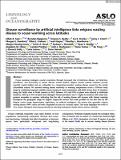Por favor, use este identificador para citar o enlazar a este item:
http://hdl.handle.net/10261/272789COMPARTIR / EXPORTAR:
 SHARE SHARE
 CORE
BASE CORE
BASE
|
|
| Visualizar otros formatos: MARC | Dublin Core | RDF | ORE | MODS | METS | DIDL | DATACITE | |

| Título: | Disease surveillance by artificial intelligence links eelgrass wasting disease to ocean warming across latitudes |
Autor: | Aoki, Lillian R.; Rappazzo, Brendan; Beatty, Deanna S.; Domke, Lia K.; Eckert, Ginny L.; Eisenlord, Morgan E.; Graham, Olivia J.; Harper, Leah; Hawthorne, Timothy L.; Hessing-Lewis, Margot; Hovel, Kevin A.; Monteith, Zachary L.; Mueller, Ryan S.; Olson, Angeleen M.; Prentice, Carolyn; Stachowicz, J. J.; Tomàs, Fiona CSIC ORCID; Yang, Bo; Duffy, Emmett; Gomes, Carla; Harvell, C. Drew | Fecha de publicación: | jul-2022 | Editor: | John Wiley & Sons | Citación: | Limnology and Oceanography 67(7): 1577-1589 (2022) | Resumen: | Ocean warming endangers coastal ecosystems through increased risk of infectious disease, yet detection, surveillance, and forecasting of marine diseases remain limited. Eelgrass (Zostera marina) meadows provide essential coastal habitat and are vulnerable to a temperature-sensitive wasting disease caused by the protist Labyrinthula zosterae. We assessed wasting disease sensitivity to warming temperatures across a 3500 km study range by combining long-term satellite remote sensing of ocean temperature with field surveys from 32 meadows along the Pacific coast of North America in 2019. Between 11% and 99% of plants were infected in individual meadows, with up to 35% of plant tissue damaged. Disease prevalence was 3× higher in locations with warm temperature anomalies in summer, indicating that the risk of wasting disease will increase with climate warming throughout the geographic range for eelgrass. Large-scale surveys were made possible for the first time by the Eelgrass Lesion Image Segmentation Application, an artificial intelligence (AI) system that quantifies eelgrass wasting disease 5000× faster and with comparable accuracy to a human expert. This study highlights the value of AI in marine biological observing specifically for detecting widespread climate-driven disease outbreaks. | Versión del editor: | https://doi.org/10.1002/lno.12152 | URI: | http://hdl.handle.net/10261/272789 | DOI: | 10.1002/lno.12152 | ISSN: | 0024-3590 |
| Aparece en las colecciones: | (IMEDEA) Artículos |
Ficheros en este ítem:
| Fichero | Descripción | Tamaño | Formato | |
|---|---|---|---|---|
| Disease_surveillance_Aoki.pdf | 4,51 MB | Adobe PDF |  Visualizar/Abrir |
CORE Recommender
SCOPUSTM
Citations
10
checked on 08-abr-2024
WEB OF SCIENCETM
Citations
9
checked on 24-feb-2024
Page view(s)
54
checked on 18-abr-2024
Download(s)
44
checked on 18-abr-2024
Google ScholarTM
Check
Altmetric
Altmetric
Este item está licenciado bajo una Licencia Creative Commons

